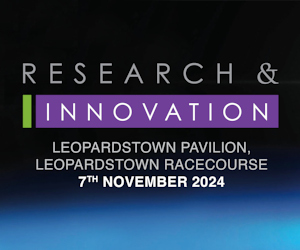Grace app co-creator looks beyond limits to innovate

In order to innovate we need to break both technology and our ways of thinking, says Lisa Domican, co-creator of the Grace App for Autism.
Necessity is the mother of invention, but for Wicklow-based Lisa Domican, motherhood brought about the need to invent.
As a parent of two children on the autistic spectrum, she knew the frustrations met by people who have limited or no verbal abilities, so she co-created the Grace App for Autism to help people communicate using pictures.
Before the Grace app, the family used a physical book with pictures inserted into it. “Gracie was non-verbal until the age of eight,” explains Domican. “She used to carry the book around and she would use the pictures inserted into it to ask for what she wanted.”
It worked, but there were drawbacks to the unwieldy system. “The book was getting bigger and bigger as we put more pictures into it, and Gracie had no way of adding to her vocabulary independently. I was very frustrated with the limitations of the system and I was constantly thinking that there has to be a better way of doing this.”
Domican had heard about a gadget called an iPhone, which was new to the market at the time, and she figured it might be worth trying. “At an event I met the corporate and social responsibility team from O2, so I decided to be a bit cheeky and I explained the situation and that I wanted to try out the pictures from the book on this new iPhone thing,” she says. “To their credit, they took a chance on us and they gave me an iPhone to try out with Gracie.”
Domican admits it took her ages to work out how to put images onto the phone, but it paid off: Gracie engaged with it immediately. Her daughter’s intuitive use of the technology drove home an important point that Domican is keen to stress: that we can assume others won’t be able to engage with technology because they don’t communicate in a typical way.
“There is a presumption that because you are non-speaking you are not smart enough,” she says. “But that is putting limitations on technology based on our own bias. The people who need the technology can often use it better than you can. They don’t have that limitation of their own fears and they see it often as a tool.”
She also believes that the ‘hacking’ approach offers a good mindset for invention. “The way you improve on technology is by trying to break it and push it,” she says. “We have to try and break it and make it do other stuff, not just what we have been told it should do.”
Domican started to talk to whomever she could about her germinating new idea. She contacted developerSteven Troughton-Smith through social media and he immediately got the concept, she recalls. “I drew him a diagram and he built an initial prototype in an afternoon. It was very exciting to have someone who could turn this idea into something real,” she says. “Then I remember sitting by the side of the swimming pool while my kids were having lessons, sketching images with a marker, and an artist redid them as graphic art for our picture set.”
That winter, Gracie tested out the prototype, and Domican (who worked in sales in her native Melbourne, Australia) kept showing it to anyone she reckoned might be able to help – including marching up to Samuel L Jackson at a gala ball for autism. When she showed the fledgling app to a senior executive at O2, she got support in the form of business coaching from that organisation.
By March 2010, the app was available for download, meaning that, with a smartphone in hand, non-verbal people with autism could use core the picture bank to communicate and learn, and they could simply take and store photos to add to their vocabulary. Since then, the app has been downloaded more than 30,000 times across three versions.
Domican is continuing to evolve the Grace app. One of the latest iOS updates allows you to set it to different languages (thanks to a donation from Tethras, meaning people can use the app to learn a language or communicate through pictures when on holidays. “You can learn to speak, say, French the way that Gracie learned to speak English,” she says. “Along with French and English, you can set it to Spanish, Danish, Arabic and Brazilian Portuguese, with more to be added on request.”
Domican has also picked up several accolades for her work, including the United Nations World Summit Award Mobile in the m-Learning & Education category in 2010 and a place on Silicon Republic’s Top 100 Women in STEM. She also delivered a talk at TEDx Dublin in 2012.
Domican’s new goal is to create “an entrepreneurial accessibility space” for young people with autism. Inspired by her teenaged son Liam’s abilities to ‘hack’ technology and code, she wants to create an environment where those talents can be harnessed vocationally when he leaves the education system.
“We need to set up a type of lab where people like Liam can do productive work, perhaps testing prototypes, so that manufacturers get more insights into how they might be used,” she says. “I’m not saying that every single person with a disability in Ireland has to be forced to work, that would be outrageous. But why not see how can we recognise a person’s ability and support them.”
One of the keys to Domican’s success has been her courage to ask for the help she needed to translate her idea into a reality. It’s something she encourages other innovators to do, too.
“Don’t be afraid to approach people,” she says. “There are so many people who want to do good and to help but they don’t know how. So ask them for what you need.”








There are no comments at the moment, do you want to add one?
Write a comment